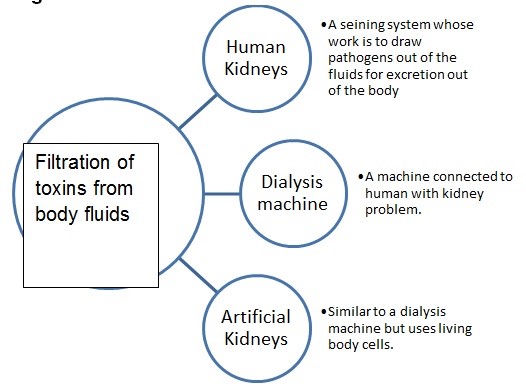Introduction
The kidney is regarded as a remarkable body organ. It is usually small in size and comprises tissues and veins. It is the primary body organ for defense against pathogens present in fluids, especially blood. Indeed, the kidney does a credible job. However, it is prone to various problems based on the history and lifestyle of an individual, as well as physical injury (Himmelfar and Sayegh, 6). Such factors can contribute to alteration in kidney functioning leading to failure. Earlier on, cases related to kidney failure were associated with death unless not both kidneys were affected. Currently, the situation has changed with the introduction of modern medicine; dialysis machines, and artificial kidneys. Dialysis machines are essential apparatus that acts as a kidney. The machine is connected to an individual with kidney problems. However, dialysis is very costly and consumes much time. Apart from this, dialysis is extremely complex and impractical. In this respect, artificial kidneys were seen as a better alternative according to research done in Ann Arbor, Michigan. This paper examines the pros and cons of artificial kidneys based on the use of the proximal convoluted tubule (PCT) cells.
The Kidney
To begin with, neurons are the main functional units of a kidney. Each nephron is comprised of the Bowman’s capsule and a coiled tubule that has three sections; the proximal and distal convoluted tubules, the Henle loop. Body wastes are emptied into the collecting tubules, then the pelvis, the main kidney cavern. And further to the urinary bladder. The urinary bladder stores the wastes awaiting elimination from the body. The nephrons using PCTplay the role of filtration on the kidney’s behalf. Human beings normally have two kidneys, but only one is necessary for blood filtration (Himmelfar and Sayegh, 14). Whenever one kidney gets affected, the other kidney can be used if it is in good condition. However, this can be worse in the case of double failure. This may prompt the affected individual to use a dialysis machine or artificial kidney.
Proximal Convoluted tubules
The PCT is a small structure found in the nephron of a kidney. The lining of PCT is made up of the epithelial cells that are interconnected to each other coupled with tight joints and covered with a border of densely packed microvilli. This helps to prevent the passage of waste products amongst other harmful materials to reach the bloodstream. The PCT filters the toxins in the blood and re-absorbs the useful materials needed by the body. The microvilli are of vital significance in this function. They increase the surface area for re-absorption of the useful material leaving the toxic ones to be filtered out of the blood.
Artificial Kidney
The artificial kidneys employ the use of real cells from a healthy kidney. The researchers in Ann Arbor hoped that the artificial kidney could perform better compared to a dialysis machine. However, the main function would remain that of filtering out toxins from the blood using the PCT. The artificial kidney was made of small porous tubes coated on their interior with molecules to attract the PCT cells. The cells were attracted to the inner surface to form a lining to facilitate filtration. Though the artificial kidney was aimed at filtering the wastes from the incoming blood similar to a dialysis machine, the device was expected to improve on hemodialysis. This is attributed to the fact that they use living cells.
Advantages
There are benefits related to artificial kidneys. First, artificial kidneys are claimed to prolong the lifespan of patients with kidney problems. Artificial kidneys have helped patients with acute kidney problems to stay alive while awaiting their kidneys to resume their functions normally. Lots of patients lived under long-term dialysis before the onset of artificial kidneys. This dialysis is prone to many complications which shorten the patient’s life span. Amongst them is the filtration problem associated with its PCT functioning. Artificial kidneys have an enhanced PCT lining that traps and filters the toxins in the blood at the same time reabsorbing the beneficial materials back to the body.
Disadvantages
On the contrary, artificial kidneys also have some setbacks. One of the setbacks is related to its functioning. Kidney’s work is to filter out the toxins contained in the blood. As earlier mentioned, the kidney’s functions are enhanced by the proximal convoluted tubules. However, these tubules filter out not only the toxins in the blood but also useful materials at times. In this respect, human PCT is not used in artificial kidneys. Therefore, the PCT cells used in artificial kidneys are derived from pigs. However, this form of kidney replacement is found to be non-compatible with human beings. In the same breath, the real kidney rejects some implants similarly for artificial kidneys.
Conclusion
Most kidney patients have relied on the dialysis machine for survival. This method has been faced with a lot of challenges and complications further worsening the situation. Artificial kidneys are hoped to improve the convenience, and effectiveness of dialysis. This paper has tried to establish the strengths and weaknesses of artificial kidneys based on PCT functionality. By having a better dialysis method majority of patients can overcome acute kidney failure. Artificial kidneys are assumed to be the perfect therapy, which will satisfy the kidney filtration function. Although artificial kidneys have saved many lives, it is not regarded as a substitute for a healthy kidney.
Relationship Diagram

Works Cited
Himmelfar, Jonathan, and M. H. Sayegh. Chronic Kidney Disease, Dialysis, and Transplantation: Companion to Brenner & Rector’s the Kidney. Philadelphia: Saunders/Elsevier, 2010. Print.